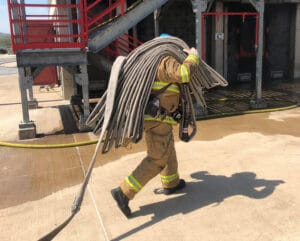Look back at any image of firemen battling a blaze before the mid-19th century and you’ll most likely see how hopeless it could be as they attempted to put out the flames by carrying bucket after bucket of water to the scene. The arrival of the hand pump made the task easier, but still had limitations in what could be done to successfully contain a raging blaze. Then in 1673, the Superintendent of the Fire Brigade in Amsterdam and his son took firefighting to a new level by sewing together 50-foot lengths of leather to fashion the first fire hose, giving firemen the advantages of closer application and more accurate delivery of water.

Here in the U.S., the fire hose first made its appearance in Philadelphia in 1794. These first hoses were initially made of canvas but were soon replaced by leather fastened together with copper rivets and washers to help overcome the tendency of the canvas to leak and the leather’s tendency to burst at higher pressures.
Eventually, leather was replaced as the go-to material around 1890 with the introduction of unlined hoses made of circular woven linen yarns that would swell when wet, creating a watertight hose that was lighter and more flexible than the bulky leather hoses used for so many years. While lighter than leather, the linen proved much less durable and was soon replaced with rubber, which was bulky and heavy like leather, but not prone to leaking.
Today’s modern fire hoses use a variety of natural and synthetic fabrics and elastomers in their construction, which allow the hoses to be stored wet without rotting and resist damage from sunlight and chemicals. They’re also lighter in weight, reducing the physical strain on firefighters.

There are several types of fire hose designs used by today’s fire service, each designed to perform specific duties. Attack hoses, supply and relay hoses, forestry and booster hoses, and suction hoses all help firefighters battle the blazes of today much more effectively and efficiently than those who came before.
As we move towards the future, fire hose research and development is expected to continue to focus on lighter, stronger, and lower maintenance materials that will perform under pressure and help tomorrow’s fire fighters better battle the fires they fight.